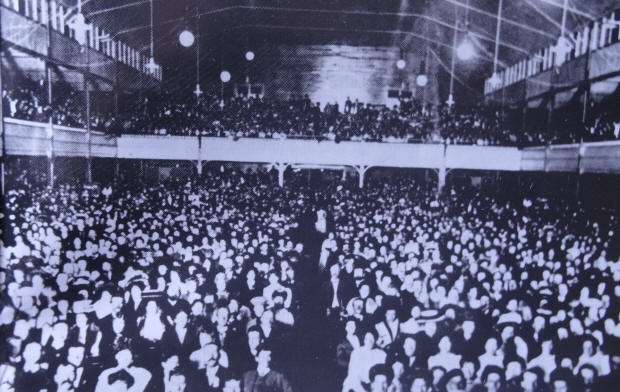South Street
With the wealth of the gold rush,
Ballarat became a thriving regional
city. For a long time it was Australia�s largest inland city until
overtaken for that title by Canberra. The good people of Ballarat were
aware of the civilising effects of culture and it was expected that a
good citizen could be expected to give a creditable rendition of a
parlour song or maybe give a recitation or play an instrument. There is
a good chance they would be the member of a choir or brass band. If they
were more of a sporty type, they could at least be expected to
participate in the more cultural forms such as
calisthenics which was,
after all, invented there on the gold fields.
Before long it was decided that a form of eisteddfod was in order as
a showcase for local talent and as a setting and gradually raising
standards in the area of performance. A group of public-minded citizens
set up the South Street Eisteddfod. In the days before the relatively
recent innovation of government arts grants, this committee knew they
were undertaking to be personally liable for any losses incurred in the
running of such an event. Before long this had become the premiere event
of its kind in Australia. Some felt that the offering of cash prizes was
not in the spirit of an eisteddfod so it was soon referred to as the
South Street Competitions or more commonly � just plain South Street.
Competitors were starting to be attracted from all over Australia,
and it wasn�t long before the good burghers of Ballarat realised they
had inadvertently created a form of event tourism. The competition
season stretched over a month and the competitors and their supporters
would spend money on accommodation, food and other necessities while
they were there. Ballarat and Melbourne music stores tendered for the
right to publish the �official� sheet music of the competition pieces.
But why just individual competitors? Band and choir competitions would
really boost the local economy. Then there were the families. Even
though your daughter had a pretty soprano voice, was it really advisable
to put her on a train to Ballarat with all those basses? Particularly
once she understood what the words of those madrigals really mean. No,
it was best that mother went too.

The finals of the choral competitions were huge events with crowds at
The Coliseum (see above) with two to three times the capacity of Melbourne's
current Hamer Hall spilling over into the streets and
often finishing well past midnight. Late finishes were not a problem. It
meant people had to stay an extra night in Ballarat. If only there was a
way to create more large team events. I�ve got it � mouth organ bands.
The mouth organ manufacturers will donate generous prizes.
But South Street was not just the domain of the gifted amateur. It
launched many an international career. In 1920 a young bass-baritone
from Geelong swept all before him winning every section of the men�s
vocal competitions that he entered. His name was
John Brownlee and this
success propelled him to the concert stages of Europe where, with the
help of Dame Nellie Melba, he quickly became accepted as one of the finer
voices of his time.
For many citizens of Ballarat between the wars, South Street was the
entertainment highlight of the year. Those who could bought seasons
tickets and many a good Ballarat citizen learned a Mozart aria or
Shakespeare scene verbatim by listening to repeated renditions of the
set piece.
After WWII, things were changing. Radio, gramophones, cinema and
eventually television were all leading to more passive forms of
entertainment. The arrival of The Beatles in Melbourne underlined the
fact that music was no longer the activity the average person
participated in, it was something they consumed. The attraction of South
Street was waning.
Never mind. A group of Ballarat citizens came up with the idea of a
historic theme park based around the gold rush. Sure enough, hundreds of
people a day came up to Sovereign Hill from Melbourne. �But they�re
still not staying overnight. Remember the days when the band and choir
competitions finished late?� �We�ll put on a sound and light show at
night � we�ll call it �Blood on the Southern Cross�.�
Never underestimate the ingenuity of Ballarat people when it comes to
event marketing. And never underestimate the impact South Street has had on the
lives of hundreds of thousands of people and the international careers
it has launched. That�s got be at least as big as The Beatles visit to
Melbourne.
|
|
Copyright © 1995 - 2025
White Hat.
|